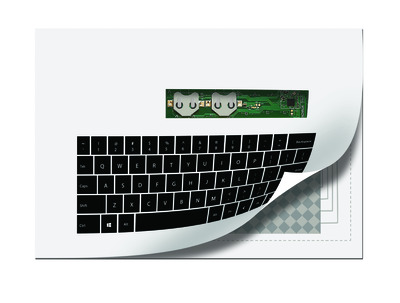Printed electronics process could support wafer-thin paper keyboards
Thursday, 28 November, 2013
UK start-up Novalia has developed a low-cost, patented manufacturing technology using standard print processes combined with capacitive touch technology that would allow Bluetooth low energy wireless control to be added to everyday low-cost materials, such as paper, card and plastic, for potentially just a few dollars in high volume.
The technology would support brand new mass-market applications such as interactive posters and books, personalised greetings cards, and entertainment and control apps using embedded Nordic Semiconductor nRF51822 system-on-chips and any Bluetooth v4.0-enabled smartphone or gadget.
The manufacturing technology - which has just won 'Flexotech International Print Award' - employs a single embedded Nordic Semiconductor nRF51822 system-on-chip (SoC) with end-user interactivity provided via a smartphone or tablet app, and requires very little manual assembly or wiring: it essentially comprises little more than a small nRF51822-based electronics module attached to the desired material.
A demo application of the technology to be displayed at the International Consumer Electronics Show (CES) at Las Vegas in January comprises a fully functioning QWERTY keyboard printed with conductive ink on a regular sheet of UK A4-sized photo paper (11.7 x 8.3″) that weighs just 30 g (not including batteries). A 4.7 x 1.0″ (120 x 25 mm) control module with battery (2 x CR2016 watch batteries) and electronics housing is just 0.08″ (2 mm) deep, while the keyboard area, according to Novalia, can be as thin as 50 microns (0.005 mm). Novalia says that this is about 10x thinner than any other keyboard ever produced and can be printed at 100 metres/minute on a standard print press.
In operation, the QWERTY keyboard keys are printed on a regular sheet of 70 gsm A4-sized paper layered on a 20x8, X-Y touch matrix substrate printed on the photo paper that can be reconfigured in software to represent any language or indeed other user or developer-assigned functionality. The nRF51822’s onboard 32-bit ARM Cortex M0 based processor manages the capacitive touch side of the application, while the SoC’s ultralow-power performance supports a battery life of up to 18 months (9 months for a single CR2032).
A simpler version of this keyboard has already been developed by Novalia. Called Switchboard, it comprises eight capacitive touch buttons printed onto an ultralightweight (28 g including a single CR2032 battery) piece of UK A5-sized printed paper mounted on foam card that can be configured to control (or be controlled by) apps running on any Bluetooth v4.0-enabled iOS device.

A free demo app from Novalia used in conjunction with the switchboard, as an illustrative example, can conduct an 8-piece Jazz or Latin music band (audio being replayed through a smartphone or tablet), control iTunes (play, pause, skip, ± volume), select up to eight specific tracks from an iTunes playlist and even send Tweets.
“The really clever bit, however, is being able to literally print touch sensors, with no metallic wiring, using local existing print processes anywhere in the world, and so at very low cost. And the functionality of all of these devices is defined in software and so could be shipped digitally,” Novalia CEO Dr Kate Stone said.
Stone continues: “In particular, I would love to see this technology being used to make everyday physical objects we all know and love, such as books and traditional music packaging, that have recently been in terminal commercial decline, perhaps being updated and possibly even made relevant again.
“And low-cost keyboards made of paper could also form part of charitable and NGO initiatives to enable even the poorest people in the developing world to access modern technology for the first time. The possibilities are endless.”
Developers kits are available from Novalia, which is actively inviting and partnering with interested companies to begin developing groundbreaking applications based on its patented technology. “The application potential of this technology is mind-boggling and if successful could possibly form the basis of a number of brand new market and product categories that simply did not and could not exist before now,” comments Geir Langeland, Nordic Semiconductor’s director of sales and marketing.
Making regular GPS ultra-precise
The GPS system can be slowed by the 'urban canyons' created by tall skyscrapers in big...
The evolution of GPS
Australia and New Zealand's positioning system, SouthPAN, will soon provide a wide range of...
Why secure GPS receivers are crucial for GNSS/INS systems
Resilient GPS/GNSS receivers protect INS systems from jamming and spoofing.




